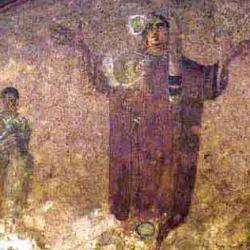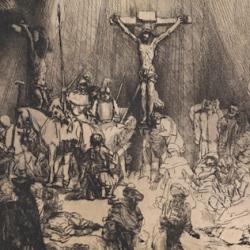In Hebrews, atonement isn’t achieved on the cross. Instead, the cross initiates a trajectory that ends with Jesus’ ascent as priest into heaven. So argues David Moffitt in Atonement and the Logic of Resurrection..
He argues that the writer to the Hebrews contrasts angels and the Son to emphasize that “it is Jesus’ perfected humanity, his blood and flesh (i.e., his human body), in heaven that sets him apart from the heavenly spirits and allows him to be the first human being to dwell fully in God’s presence and to obtain the fullness of God’s promises. Jesus entered the world to come when he ascended into heaven and, because he is a human being, was invited to reign and rule over that world” (42).
Resurrection is the beginning of Jesus’ ascent to heavenly, human priesthood. He denies that Hebrews teaches a “two-stage” model of Yom Kippur, a descent followed by an ascent. Instead, “Jesus’ suffering exemplifies his greatest moment of testing and faithful endurance. As a result of his obedience in suffering, God rewarded him with the ‘better resurrection.’ In his suffering, Jesus stands as the example of the righteous sufferer par excellence” (42).
Instead of being the be-all of atonement, “Jesus’ death is identified by the author as the trigger that sets into motion the chain of events that culminates in atonement. Jesus’ resurrection, however, marks a central and discrete moment in the larger sequence put into motion by Jesus’ crucifixion. Because Jesus’ human body rose to indestructible life, he is able to present his blood . . . , his body, and himself in the very place where the author says he presented these things—before God in heaven. Jesus’ atoning offering occurred precisely where the author depicts it occurring—in heaven, not on the cross” (42).
He reiterates: “the writer of Hebrews identifies Jesus’ death as the moment that puts into motion a sequence of events that ultimately results in his exaltation to the throne at God’s right hand. These events are the resurrection of Jesus’ human body, his ascension into heaven, his presentation of his atoning offering—that is, his very life—and his session at God’s right hand. The resurrection is the event that qualifies him to become the high priest he now is. The ascension brings Jesus’ immortal humanity into heaven. Because he arose into his high priesthood, Jesus entered into God’s presence in heaven. There he made his atoning offering. After making that offering, he took his seat at the throne at God’s right hand. The final event, for which the author waits, is the moment when the living Jesus will return to earth and bring salvation—the fullness of all of God’s promises—to those who faithfully endure in their confession of him” (42-3).
Later, after surveying the eschatological cosmology of Hebrews, he applies it to the ascended body of Jesus, which makes his humanity angelic. Angels “shine, have enduring life, and can dwell in God’s presence.” Through Jesus, human beings are “brought near to God’s throne and with a change in their relationship with the angels.”
This doesn’t erase the ontological distinction of angels and human beings. Rather, the ascension restores “humanity to the pinnacle of God’s creation. For the author of Hebrews Jesus represents the first human to have been made fit to enter fully into God’s presence and be elevated above the angels. Jesus has been glorified, but not in such a way as to have lost his humanity. He is in heaven not as a ministering πνεῦμα, but as a ministering anthropos—the great high priest. This implies that when he ascended into heaven, he did so with his human body, which implies further that the author thinks in terms of Jesus arising bodily from the dead” (212-3).
Moffitt finds various hints that the resurrection plays a crucial role in the soteriology of Hebrews: “he speaks of Jesus being saved out of death in language he elsewhere connects with resurrection (cf. Heb 5:7; 11:19). Additionally, he explicitly refers to Jesus arising to indestructible life. This latter point indicates a transformation in Jesus’ life. There was a time when he was subject to death. But, through his suffering he was crowned with glory; he was perfected (2:9–10)” (212-3).
“Perfection implies that Jesus is “made fit, in his humanity, to enter the heavenly realms. Only as the one who, after death, has been made perfect is he qualified to serve as the ever-living heavenly high priest. That there was a moment in which Jesus was perfected, and that this moment matters for the high-priestly Christology of the author, follows from the way he emphasizes perfection as that attribute that qualifies Jesus to be granted high-priestly status. On earth Jesus’ tribal lineage prevents him from serving as a priest. Only by being perfected—by being transformed such that he has an enduring life—can Jesus become a high priest” (212-3).
Against some earlier scholarship, Moffitt argues that “the idea that Hebrews conflates Jesus’ ascension and resurrection by conceiving of the latter in spiritual terms, can no longer stand. There is no spiritualization of Jesus’ resurrection. Rather, internal and external evidence suggest that the author of Hebrews believed that Jesus died, rose again with his human body, ascended with that body into heaven, and sat down at the right hand of the Most High. The recognition of the importance of Jesus’ glorified or perfected humanity in heaven explains the logic that unites the two foci around which the author’s Christology is centered—the elevation of Jesus above the angels to the divine throne in heaven and the high-priestly service he renders there in God’s presence” (212-3).
A few comments. First, the sequence of cross-to-ascension is precisely the sequence of Levitical sacrifice. In Leviticus, atonement isn’t completed by the death of the animal; it’s completed only when the priestly animal ascends in smoke to Yahweh. Second, the sequence Moffitt describes also fits with John’s presentation of the cross in his Gospel: It is the beginning of an ascent to the Father. Finally, “perfection” in Hebrews has (as David Peterson showed) an eschatological connotation; perfected in death, Jesus is qualified to enter eschatological life in the heavenly sanctuary. This too is rooted in Leviticus (what isn’t?), where ordination is a “filling” (LXX of Exodus 29:22 talks about the ordination ram as the ram of teleiosis; cf. Hebrews 7:11).
Which is to say: Moffitt has shown that the author of Hebrews was an assiduous student of Leviticus.












